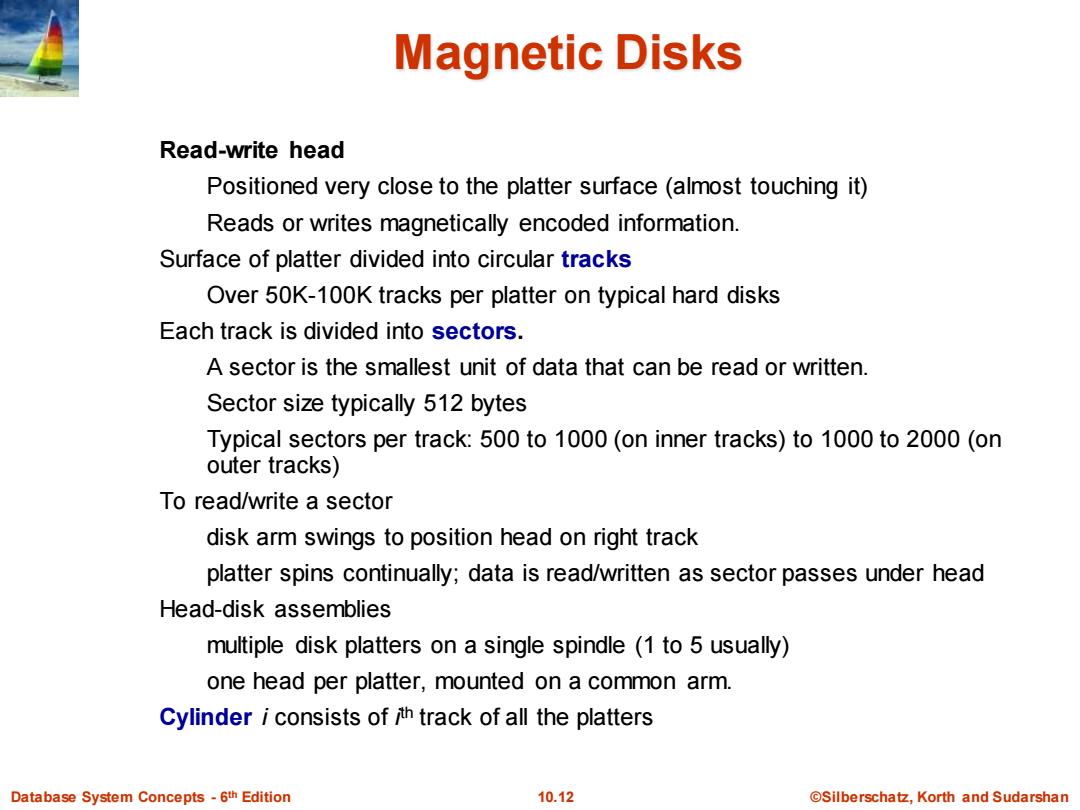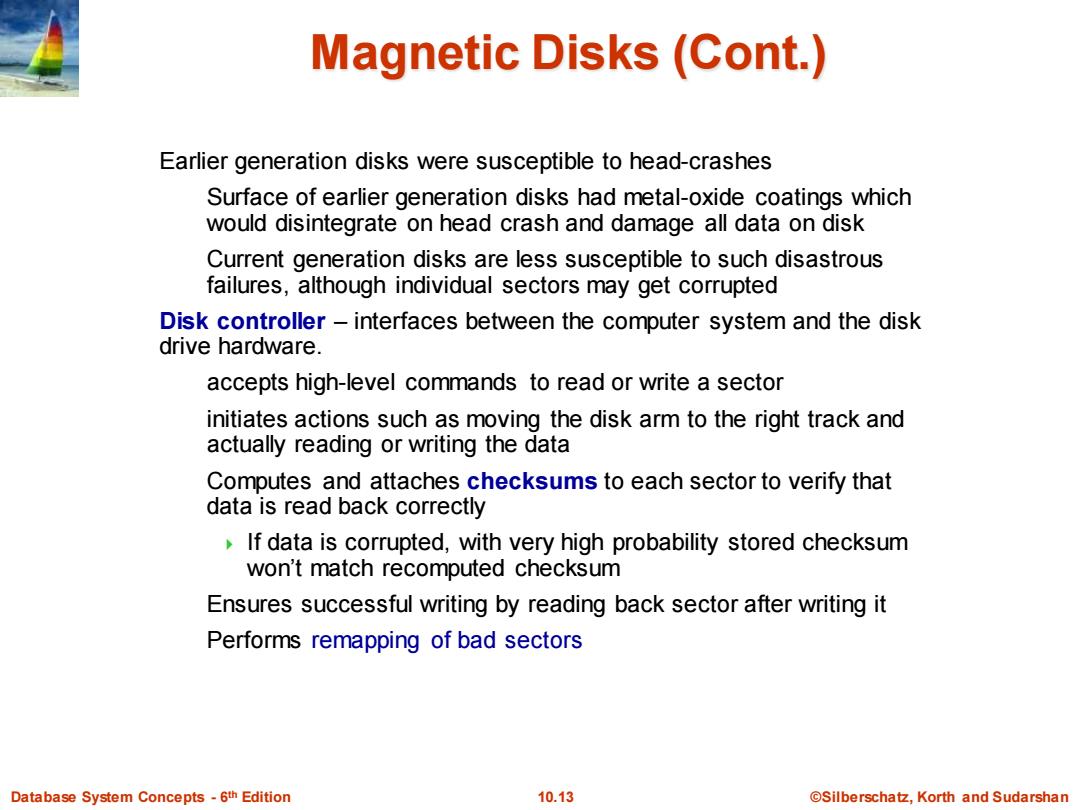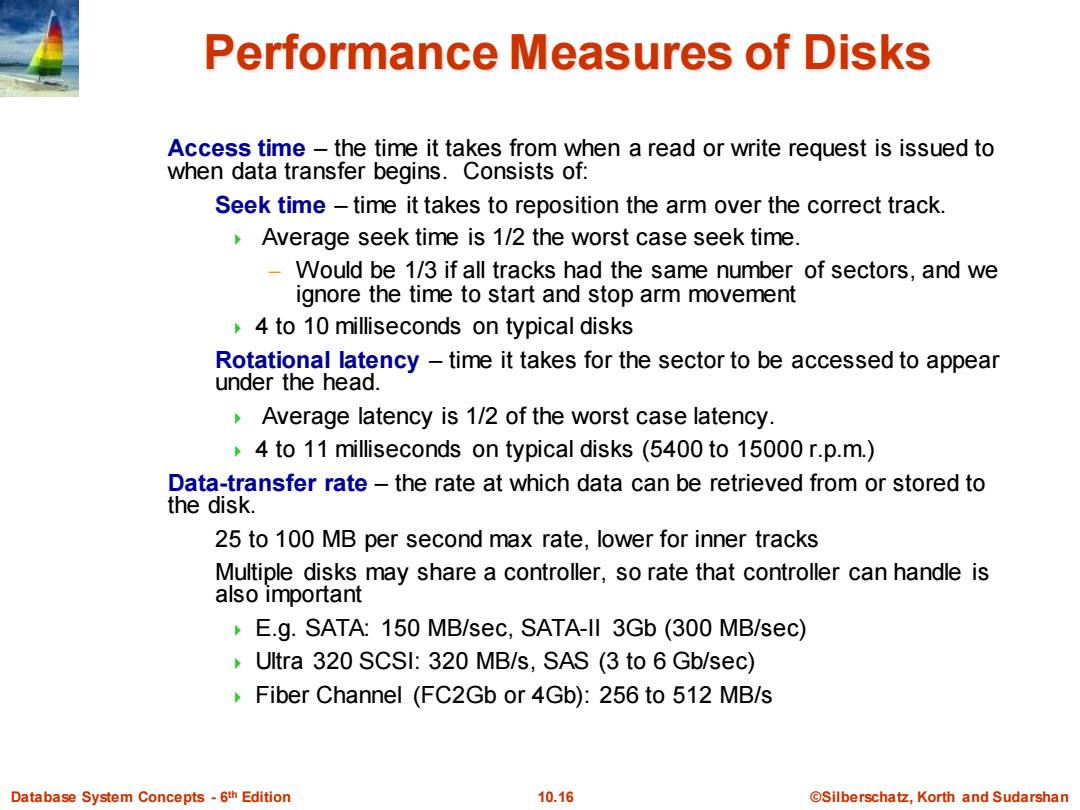
Magnetic Disks Read-write head Positioned very close to the platter surface(almost touching it) Reads or writes magnetically encoded information. Surface of platter divided into circular tracks Over 50K-100K tracks per platter on typical hard disks Each track is divided into sectors. A sector is the smallest unit of data that can be read or written. Sector size typically 512 bytes Typical sectors per track:500 to 1000(on inner tracks)to 1000 to 2000(on outer tracks) To read/write a sector disk arm swings to position head on right track platter spins continually;data is read/written as sector passes under head Head-disk assemblies multiple disk platters on a single spindle(1 to 5 usually) one head per platter,mounted on a common arm. Cylinder i consists of ith track of all the platters Database System Concepts-6th Edition 10.12 @Silberschatz,Korth and Sudarshan
Database System Concepts - 6 10.12 ©Silberschatz, Korth and Sudarshan th Edition Magnetic Disks Read-write head Positioned very close to the platter surface (almost touching it) Reads or writes magnetically encoded information. Surface of platter divided into circular tracks Over 50K-100K tracks per platter on typical hard disks Each track is divided into sectors. A sector is the smallest unit of data that can be read or written. Sector size typically 512 bytes Typical sectors per track: 500 to 1000 (on inner tracks) to 1000 to 2000 (on outer tracks) To read/write a sector disk arm swings to position head on right track platter spins continually; data is read/written as sector passes under head Head-disk assemblies multiple disk platters on a single spindle (1 to 5 usually) one head per platter, mounted on a common arm. Cylinder i consists of i th track of all the platters

Magnetic Disks(Cont.) Earlier generation disks were susceptible to head-crashes Surface of earlier generation disks had metal-oxide coatings which would disintegrate on head crash and damage all data on disk Current generation disks are less susceptible to such disastrous failures,although individual sectors may get corrupted Disk controller-interfaces between the computer system and the disk drive hardware. accepts high-level commands to read or write a sector initiates actions such as moving the disk arm to the right track and actually reading or writing the data Computes and attaches checksums to each sector to verify that data is read back correctly If data is corrupted,with very high probability stored checksum won't match recomputed checksum Ensures successful writing by reading back sector after writing it Performs remapping of bad sectors Database System Concepts-6th Edition 10.13 @Silberschatz,Korth and Sudarshan
Database System Concepts - 6 10.13 ©Silberschatz, Korth and Sudarshan th Edition Magnetic Disks (Cont.) Earlier generation disks were susceptible to head-crashes Surface of earlier generation disks had metal-oxide coatings which would disintegrate on head crash and damage all data on disk Current generation disks are less susceptible to such disastrous failures, although individual sectors may get corrupted Disk controller – interfaces between the computer system and the disk drive hardware. accepts high-level commands to read or write a sector initiates actions such as moving the disk arm to the right track and actually reading or writing the data Computes and attaches checksums to each sector to verify that data is read back correctly If data is corrupted, with very high probability stored checksum won’t match recomputed checksum Ensures successful writing by reading back sector after writing it Performs remapping of bad sectors

Disk Subsystem system bus disk controller disks Multiple disks connected to a computer system through a controller Controllers functionality(checksum,bad sector remapping)often carried out by individual disks;reduces load on controller Disk interface standards families ATA(AT adaptor)range of standards SATA(Serial ATA) SCSI(Small Computer System Interconnect)range of standards SAS(Serial Attached SCSI) Several variants of each standard(different speeds and capabilities) Database System Concepts-6th Edition 10.14 ©Silberschat乜,Korth and Sudarshan
Database System Concepts - 6 10.14 ©Silberschatz, Korth and Sudarshan th Edition Disk Subsystem Multiple disks connected to a computer system through a controller Controllers functionality (checksum, bad sector remapping) often carried out by individual disks; reduces load on controller Disk interface standards families ATA (AT adaptor) range of standards SATA (Serial ATA) SCSI (Small Computer System Interconnect) range of standards SAS (Serial Attached SCSI) Several variants of each standard (different speeds and capabilities)

Disk Subsystem Disks usually connected directly to computer system In Storage Area Networks(SAN),a large number of disks are connected by a high-speed network to a number of servers In Network Attached Storage (NAS)networked storage provides a file system interface using networked file system protocol,instead of providing a disk system interface Database System Concepts-6th Edition 10.15 @Silberschatz,Korth and Sudarshan
Database System Concepts - 6 10.15 ©Silberschatz, Korth and Sudarshan th Edition Disk Subsystem Disks usually connected directly to computer system In Storage Area Networks (SAN), a large number of disks are connected by a high-speed network to a number of servers In Network Attached Storage (NAS) networked storage provides a file system interface using networked file system protocol, instead of providing a disk system interface

Performance Measures of Disks Access time-the time it takes from when a read or write request is issued to when data transfer begins.Consists of: Seek time-time it takes to reposition the arm over the correct track. Average seek time is 1/2 the worst case seek time. -Would be 1/3 if all tracks had the same number of sectors,and we ignore the time to start and stop arm movement 4 to 10 milliseconds on typical disks Rotational latency-time it takes for the sector to be accessed to appear under the head. Average latency is 1/2 of the worst case latency. 4 to 11 milliseconds on typical disks (5400 to 15000 r.p.m.) Data-transfer rate-the rate at which data can be retrieved from or stored to the disk. 25 to 100 MB per second max rate,lower for inner tracks Multiple disks may share a controller,so rate that controller can handle is also important E.g.SATA:150 MB/sec,SATA-lI 3Gb(300 MB/sec) Ultra 320 SCSI:320 MB/s,SAS (3 to 6 Gb/sec) Fiber Channel (FC2Gb or 4Gb):256 to 512 MB/s Database System Concepts-6th Edition 10.16 @Silberschatz,Korth and Sudarshan
Database System Concepts - 6 10.16 ©Silberschatz, Korth and Sudarshan th Edition Performance Measures of Disks Access time – the time it takes from when a read or write request is issued to when data transfer begins. Consists of: Seek time – time it takes to reposition the arm over the correct track. Average seek time is 1/2 the worst case seek time. – Would be 1/3 if all tracks had the same number of sectors, and we ignore the time to start and stop arm movement 4 to 10 milliseconds on typical disks Rotational latency – time it takes for the sector to be accessed to appear under the head. Average latency is 1/2 of the worst case latency. 4 to 11 milliseconds on typical disks (5400 to 15000 r.p.m.) Data-transfer rate – the rate at which data can be retrieved from or stored to the disk. 25 to 100 MB per second max rate, lower for inner tracks Multiple disks may share a controller, so rate that controller can handle is also important E.g. SATA: 150 MB/sec, SATA-II 3Gb (300 MB/sec) Ultra 320 SCSI: 320 MB/s, SAS (3 to 6 Gb/sec) Fiber Channel (FC2Gb or 4Gb): 256 to 512 MB/s